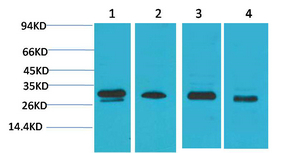AMPKβ2 Polyclonal Antibody
- Catalog No.:YN5679
- Applications:WB
- Reactivity:Human;Mouse;Rat
- Target:
- AMPKβ2
- Fields:
- >>FoxO signaling pathway;>>AMPK signaling pathway;>>Longevity regulating pathway;>>Longevity regulating pathway - multiple species;>>Apelin signaling pathway;>>Tight junction;>>Circadian rhythm;>>Thermogenesis;>>Insulin signaling pathway;>>Adipocytokine signaling pathway;>>Oxytocin signaling pathway;>>Glucagon signaling pathway;>>Insulin resistance;>>Non-alcoholic fatty liver disease;>>Alcoholic liver disease;>>Hypertrophic cardiomyopathy
- Gene Name:
- PRKAB2
- Protein Name:
- 5'-AMP-activated protein kinase subunit beta-2
- Human Gene Id:
- 5565
- Human Swiss Prot No:
- O43741
- Mouse Swiss Prot No:
- Q6PAM0
- Rat Swiss Prot No:
- Q9QZH4
- Immunogen:
- Recombinant Protein of AMPKβ2
- Specificity:
- The antibody detects endogenous AMPKβ2 protein.
- Formulation:
- PBS, pH 7.4, containing 0.5%BSA, 0.02% sodium azide as Preservative and 50% Glycerol.
- Source:
- Polyclonal, Rabbit,IgG
- Dilution:
- WB 1:1000-2000
- Purification:
- The antibody was affinity-purified from rabbit antiserum by affinity-chromatography using epitope-specific immunogen.
- Storage Stability:
- -15°C to -25°C/1 year(Do not lower than -25°C)
- Other Name:
- PRKAB2;5'-AMP-activated protein kinase subunit beta-2;AMPK subunit beta-2
- Observed Band(KD):
- 30kD
- Background:
- The protein encoded by this gene is a regulatory subunit of the AMP-activated protein kinase (AMPK). AMPK is a heterotrimer consisting of an alpha catalytic subunit, and non-catalytic beta and gamma subunits. AMPK is an important energy-sensing enzyme that monitors cellular energy status. In response to cellular metabolic stresses, AMPK is activated, and thus phosphorylates and inactivates acetyl-CoA carboxylase (ACC) and beta-hydroxy beta-methylglutaryl-CoA reductase (HMGCR), key enzymes involved in regulating de novo biosynthesis of fatty acid and cholesterol. This subunit may be a positive regulator of AMPK activity. It is highly expressed in skeletal muscle and thus may have tissue-specific roles. Multiple alternatively spliced transcript variants have been found for this gene. [provided by RefSeq, Jul 2013],
- Function:
- function:AMPK is responsible for the regulation of fatty acid synthesis by phosphorylation of acetyl-CoA carboxylase. Also regulates cholesterol synthesis via phosphorylation and inactivation of hydroxymethylglutaryl-CoA reductase and hormone-sensitive lipase. This is a regulatory subunit, may be a positive regulator of AMPK activity. It may also serve as an adapter molecule for the catalytic alpha-subunit.,PTM:Phosphorylated when associated with the catalytic subunit.,similarity:Belongs to the 5'-AMP-activated protein kinase beta subunit family.,subunit:Heterotrimer of an alpha catalytic subunit, a beta and a gamma non-catalytic regulatory subunits.,
- Subcellular Location:
- nucleoplasm,cytosol,nucleotide-activated protein kinase complex,
- Expression:
- Liver,Pancreas,
- June 19-2018
- WESTERN IMMUNOBLOTTING PROTOCOL
- June 19-2018
- IMMUNOHISTOCHEMISTRY-PARAFFIN PROTOCOL
- June 19-2018
- IMMUNOFLUORESCENCE PROTOCOL
- September 08-2020
- FLOW-CYTOMEYRT-PROTOCOL
- May 20-2022
- Cell-Based ELISA│解您多样本WB检测之困扰
- July 13-2018
- CELL-BASED-ELISA-PROTOCOL-FOR-ACETYL-PROTEIN
- July 13-2018
- CELL-BASED-ELISA-PROTOCOL-FOR-PHOSPHO-PROTEIN
- July 13-2018
- Antibody-FAQs
- Products Images

- Western blot analysis of 1) 293T, 2) HepG2, 3) Mouse Heart Tissue, 4) Rat Heart Tissue using AMPKβ2 Polyclonal Antibody. Secondary antibody(catalog#:RS0002) was diluted at 1:20000



